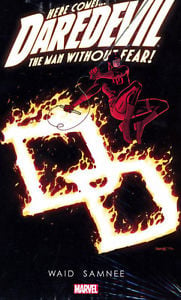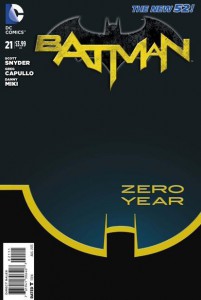5. Captain Marvel (Marvel)
Captain Marvel #9-#17
Writers: Kelly Sue DeConnick (9-17), Christopher Sebela (10-12), Jen Van Meter (15-16)
Pencillers: Filipe Andrade (9-12, 17), Scott Hepburn (13-14), Gerardo Sandoval (13-14), Pat Oliffe (15)
Inker: Filipe Andrade (9-12, 17), Scott Hepburn (13-14), Gerardo Sandoval (13-14), Drew Geraci (15-16), Tom Nguyen (16)
Colorist: Jordie Bellaire (9-13, 17), Andy Troy (13-16)
Publisher: Marvel Comics
Kelly Sue DeConnick took B-list Avenger (or C-list depend on who you’re asking), Carol Danvers, and created one of the best debut comics of 2012, promoting the former Ms. Marvel to Captain Marvel, after her deceased mentor. 2013 has been Carol Danvers’ best year ever; she’s never been more popular, and her comics have never been this good. She started off the year with #9 of her monthly series, a day-in-the-life one-shot similar to what Matt Fraction has been doing with Hawkeye. It’s a real standout issue with cameos by Tony Stark and Spider-Woman, and it features a fight against dinosaurs on the city streets. But, at its heart, it’s about Carol’s relationships with those closest in her life. And it ends with a bombshell: because of a brain lesion, she is told she can no longer fly (or risk death). The resulting arc features a grounded Captain Marvel going through a major life crisis when she’s deprived of her main super-power. Not being to save others on her own terms, she faces obstacles she’s never had before.
DeConnick excels at pacing and juggling narratives, and these issues frequently go back and forth between the drama in Carol’s life, including hospital visits, and action scenes against Deathbird. Captain Marvel has played host to several unconventional art interiors throughout its run, with Filipe Andrade drawing most of the issues from 2013 (#9-12, #17). He has an unusual, through visually striking style, particularly in faces, but they convey the appropriate amount of emotion when the story asks for it. He shines most during action, and thankfully Captain Marvel has plenty in that department, and consistently excels at it. Carol had a big cross-over between her title series and Avengers Assemble (also written by DeConnick). The five issue “The Enemy Within” story gives Carol the spotlight during a catastrophe so large it demands the Avengers. Her brain lesion is a major source of conflict, and the story’s finale is a genuine game-changing shake up (and a tear jerker, at that). What follows is a two issue Infinity tie-in that would be completely disposable if not for their direct handling of Carol’s life immediately post-“Enemy Within”. Last month’s #17 is a touching season finale to “Captain Marvel”, which in one issue illustrates what makes Carol Danvers such an important character in current-day comics. Volume 2 debuts April 2014, and it’s one of this writer’s most anticipated comics of the entire year (along with its sorta-spinoff Ms. Marvel).
-Trevor Dobbin
Daredevil #22-#34
Writer: Mark Waid
Pencillers: Chris Samnee (22-27, 30-33), Javier Rodriguez (28-29, 34)
Inkers: Chris Samnee (22-27, 30-33), Alvaro Lopez (28-29, 34)
Colorist: Javier Rodriguez
Publisher: Marvel Comics
Daredevil, Marvel’s blind, swashbuckling super-hero/lawyer (which is kind of like being a ice-cream vendor/pirate but whatever) has passed through a lot of talented writers, from Frank Miller (before he went insane and crappy) to Ed Brubaker. However, since taking over the title with a new ongoing last year, Mark Waid is on the fast track to becoming one of the best Daredevil writers in recent memory, if not ever.
What really works about Waid’s work on “Daredevil” is how he’s taken the character in a new direction, but one that entirely makes sense. Especially in Brubaker’s Daredevil work, the grim n’ gritty factor reached new heights, with a broodier than ever Daredevil’s life finding new and exciting ways to kick him in the stones with virtually every issue, sending him further and further down what would be a road of facial tattoos and red lightsabers, if this were an entirely different franchise. Later on, under the writing of Andy Diggle, Daredevil was even possessed by a demon. Because…..comics.
Waid, on the other hand, took a look at all this darkness and grit and met it with a resounding “eff that”, and started his series off by having a newly recovered hornhead decide to stop being such a mopey Mark about it all and return to his roots as a happy-go-lucky swashbuckler.
But what makes it interesting is how the series keeps setting him up for a relapse. Daredevil’s always been somewhat bi-polar as a character, something even his supporting cast have been quick to point out. Is the new happy outlook just a front? And if so, how long will it take for it to crumble away sending him further down the dark path than ever?
Add to that the fact that the series seemingly prides itself on what some other writers may consider anachronistic, straightforward superhero action. Want a sprawling, densely-packed epic that you need to be reading three other series to fully get? Well go somewhere else, this book has a standalone issue where Daredevil and Spider-Man fight Stilt-Man. Not the gritty new version of Stilt-Man. Just plain ole Stilt-Man. In a world full of “badass” reinventions of old characters, you gotta admire a comic that unabashedly presents a villain whose sole gimmick is that he’s on stilts.
-Thomas O’Connor
The Wake #1-#5
Writer: Scott Snyder
Art: Sean Murphy
Colors: Matt Hollingsworth
Publisher: Vertigo Comics
The Wake is a horror miniseries following the crew of a submarine as they investigate an anomalous sound near a “Ghost Rig” in a very deep part of the ocean. Each issue of the series is bookmarked by flashbacks and flash forwards that depict different eras of the Earth. The Wake is definitely one of the most intelligent comics of 2013. Scott Snyder blends oceanography and mythology/folklore along with horror and action adventure elements to create a scary, suspenseful story, which also happens to have a bit of brain. He creates a diverse team of characters from the protagonist Dr. Lee Archer, a single mother and cetologist that has a personal connection with the anomaly to quirky folklore professor Dr. Marin and Meeks, a gruff hunter and security detail. Snyder does a great job developing Archer’s character throughout the series and giving each crew member a unique response to the terrors around them. He also plays with time and pacing making one issue a slow-burning character driven issue and filling another one with deaths and chase scenes while bringing things to a simultaneously epic and mindboggling conclusion in The Wake #5.
Sean Murphy and Matt Hollingsworth’s art bring the cluttered, spooky world of The Wake to life. From abandoned oil rigs to the all too quiet ocean and a Merman in a stasis chambers, Murphy’s pencils add details and atmosphere to Snyder’s script. His figures have a variety of body shapes and facial expressions depending on the situation. But his biggest strength in The Wake is the monsters he makes for both the present and bookmark scenes. Colorist Matt Hollingsworth uses a predominantly dark palette to give the comic a “watery grave” feeling. Nothing is permanent, and no one is safe in the world of The Wake. Neither science nor faith can save Lee Archer and her crew mates from the undiscovered denizens of the ocean. The Wake will probably end up being Scott Snyder’s magnum opus, and it explores some huge questions, like the connection between mythology and science and human responses to dangerous situations, while still having interesting characterization and telling a fast-paced action/horror story.
-Logan Dalton
Saga #9-17
Writer: Brian K. Vaughan
Art: Fiona Staples
Publisher: Image
The breakout comic of 2012 and everyone’s favourite indie series is probably the most consistently excellent title of 2013 and gradually gets better every few issues. Saga has gotten a lot of comparisons to Star Wars, The Lord of the Rings, and Game of Thrones, largely because of its storytelling structure, epic scope, vast fantastical world-building. The comic does definitely excel in those regards, but its comparisons to those films/shows runs only skin deep. Saga is the work of auteurs, and in its uncompromising, unconventional approach to craft it feels more like the work of Scorsese or Tarantino at the top of their game. Brian K. Vaughan is the most noteworthy director in comics of the year, and Fiona Staples one of the most stunningly original directors of photography in many years. Saga is the most-talked-about comic right now, and deservedly so. Also, can we take a minute to talk about about refreshingly progressive it is? Women fighting in wars without a big deal being made of it, gay characters and others with a fluid sexual orientation, androgyny and gender fluidity along with one of the most ethnically and racially diverse cast of characters ever in a popular comic. There are also natural depictions of sex as just A Regular Thing People Do. It also wins out in comics this year as having the greatest female-representation overall. Saga is many things, and it is impossible to discuss all of them in this short block of text. It is also vulgar, funny, and heartbreaking (Vaughan is definitely not afraid to kill of a character you love, so watch out). And if you haven’t yet been convinced to start reading Saga, there’s a cute overalls-wearing seal that talks.
– Trevor Dobbin
Batman #16-#26
Writer: Scott Snyder
Pencillers: Greg Capullo (16-17, 19-26), Andy Kubert (18)
Inker: Jonathan Glapion (16-17), Sandra Hope (18), Danny Miki (19-26)
Colorist: FCO Plascencia (16-17, 19-26)
Publisher: DC Comics
In their third year on the title, Scott Snyder and Greg Capullo continue to make Batman the best issue by issue comic on the shelves. 2013 was a very emotional year for Batman as the Dark Knight sees his “family” broken apart by the Joker, mourns his son Damian’s death, and has to prevent Clayface from framing Bruce Wayne for a crime he didn’t commit. But Snyder and Capullo’s greatest achievement on Batman is the ongoing “Zero Year” storyline, which revisited Batman’s origin and added new elements to it, such as a closer connection to his rogues’ gallery and glimpses of his childhood and training. Snyder and Capullo build the foundation of the Batman mythos from the ground up through plot, dialogue, and visuals. Caption boxes provide a glimpse of Bruce’s tortured psyche and his reasons for wanting to protect Gotham. Continuing the main theme of his whole run from “Court of the Owls onward, Snyder focuses on Batman’s relationship to Gotham City and develops both his and Gotham’s character while telling a puzzling mystery story with plenty of action beats.
But the real star of the Batman book is penciller Greg Capullo, who drew every issue of the title, except one. Capullo has a great sense of the grotesque that he brings to Batman’s villains from the faceless Joker in “Death of the Family” to Clayface, the insane Red Hood, and more recently Doctor Death. He also excels at facial expressions which add emotional depth to his characters, especially Bruce and Alfred. Capullo’s action scenes are brutal and full of blood and vinegar. There is also a marked contrast between Batman’s fighting techniques in “Death of the Family” and the Clayface story and “Zero Year”. Capullo, inkers Jonathan Glapion and Danny Miki, and colorist FCO Plascencia build the multi-layered world, characters, and themes that Snyder creates with his words and make Batman a visual treat.
-Logan Dalton





